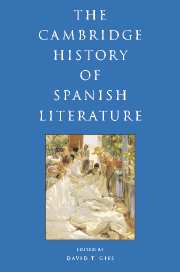Book contents
- Frontmatter
- I INTRODUCTION
- II HISTORY AND CANONICITY
- III THE MEDIEVAL PERIOD
- IV EARLY MODERN SPAIN: RENAISSANCE AND BAROQUE
- V THE ENLIGHTENMENT AND NEOCLASSICISM
- VI THE FORGING OF A NATION: THE NINETEENTH CENTURY
- VII THE MODERN, MODERNISMO, AND THE TURN OF THE CENTURY
- VIII TWENTIETH-CENTURY SPAIN AND THE CIVIL WAR
- 41 Poetry between 1920 and 1940
- 42 Prose: early twentieth century
- 43 The commercial stage, 1900–1936
- 44 Theatrical reform and renewal, 1900–1936
- 45 Federico García Lorca
- IX IN AND OUT OF FRANCO SPAIN
- X POST-FRANCO SPANISH LITERATURE AND FILM
- Bibliography
- Index
- References
41 - Poetry between 1920 and 1940
from VIII - TWENTIETH-CENTURY SPAIN AND THE CIVIL WAR
Published online by Cambridge University Press: 28 March 2008
- Frontmatter
- I INTRODUCTION
- II HISTORY AND CANONICITY
- III THE MEDIEVAL PERIOD
- IV EARLY MODERN SPAIN: RENAISSANCE AND BAROQUE
- V THE ENLIGHTENMENT AND NEOCLASSICISM
- VI THE FORGING OF A NATION: THE NINETEENTH CENTURY
- VII THE MODERN, MODERNISMO, AND THE TURN OF THE CENTURY
- VIII TWENTIETH-CENTURY SPAIN AND THE CIVIL WAR
- 41 Poetry between 1920 and 1940
- 42 Prose: early twentieth century
- 43 The commercial stage, 1900–1936
- 44 Theatrical reform and renewal, 1900–1936
- 45 Federico García Lorca
- IX IN AND OUT OF FRANCO SPAIN
- X POST-FRANCO SPANISH LITERATURE AND FILM
- Bibliography
- Index
- References
Summary
Groups and poetics
For years literary historians have reluctantly used concepts such as “Generation of 1927” or “Grupo del 27,” and “Generation of 1936” to refer to the poetry of the first half of the twentieth century in Spain. Perhaps it is more exact to refer (following María Zambrano’s designation) to a “momento histórico” (“historic moment”), that is an impressive convergence that brought together certain individuals and certain poetic modalities which produced publications and public events which had a strong impact on the formation of a literary canon. The 1920s and 1930s were the peak of a period of intense literary and artistic renovation, a period which has justly been called a “Silver Age” in Spanish culture, abruptly interrupted by the Civil War.
Overall we can distinguish a few characteristics which define the moment. One is the vindication (and mixing together) of figures of the Spanish poetic tradition such as Góngora and Garcilaso, Bécquer and Darío, and of course the major poet of the first decades of the century, Juan Ramón Jiménez. All of these poets were considered to be models of a certain artistic purity and interest in poetical form. This implied that new authors were attracted to the Avant-Garde and experimentation with form, and the consolidation of a model taken from Stéphane Mallarmé: the “Book” as a way to organize poetry collections. Some of the new authors had a genuine sense of verse and rhythm (Federico García Lorca, Rafael Alberti, Miguel Hernández). Others wrote luminous intellectual constructs where everyday life shines under new light (Pedro Salinas, Jorge Guillén).
- Type
- Chapter
- Information
- The Cambridge History of Spanish Literature , pp. 553 - 568Publisher: Cambridge University PressPrint publication year: 2005



